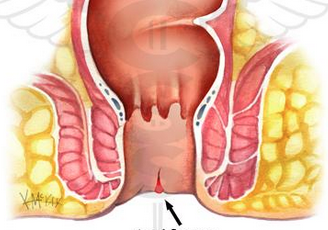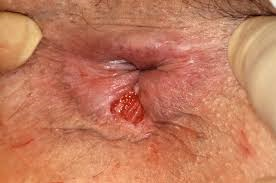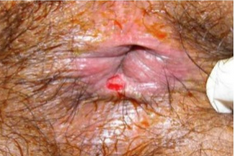ANAL FISSURE
An anal fissure is a common condition that can affect people of all ages due to a low-fiber diet and lack of exercise. Although not a severe effect, it also causes a little trouble for the patient.
What is an anal fissure?
An anal fissure is a small tear in the lining of the anus. It can happen when large or hard stools pass, squeeze during birth, or experience constipation or diarrhea episodes.
Anal fissures can cause throbbing pain and bleeding during and after a bowel movement. It can also cause itching and burning in the anal area.
An anal fissure is usually mild, and in most cases, it will heal on its own within four to six weeks. Home remedies can help relieve pain and heal.

Who can get anal fissures?
Anal fissures are relatively common, with an estimated 1 out of 10 people affected at some point in their life.
Anal fissures can happen to both men and women and can also happen to babies. However, most cases occur in children and adolescents between the ages of 10 and 30.
What are the anal fissure symptoms?
Signs and symptoms of an anal fissure include:
• A visible tear in the skin around the anus
• A skin tag or small lump in the skin next to the tear
• Sharp pain in the anal area during bowel movements
• Streaks of blood in the stool or on paper after wiping
• Burning or itchy in the anal area

What is the complication of the anal fissure?
An anal fissure that fails to heal within six weeks is considered chronic.
If you have an anal fissure, there is a risk of relapse.
An anal fissure may extend into the ring of muscle, making it more difficult for your anal fissure to heal.
What causes an anal fissure?
Anal fissures are most common when the stools are large or hard. Chronic constipation or frequent diarrhea can also tear the skin around the anus. Other common causes include:
• Crohn's disease or other inflammatory bowel diseases (IBD)
• Pregnancy and childbirth
• Reduced blood flow to the anal rectal area
• Overly tight or spastic anal sphincter muscles
In rare cases, anal fissures can be caused by:
• Anal cancer
• HIV
• Tuberculosis
• Syphilis
• Herpes
How is an anal fissure diagnosed?
A doctor can often diagnose an anal fissure simply by examining the area around the anus and in the anus with a finger.
Sigmoidoscopy helps diagnose the disease as well as find other causes such as hemorrhoids, etc

How is an anal fissure treated?
Most anal fissures do not require excessive treatment. Several home remedies can help promote healing and relieve unpleasant symptoms. However, if the fissure does not heal in 6-8 weeks, the patient needs medication or even surgery.
You can treat an anal fissure at home by:
• Using a stool softener.
• Add fiber and increase your intake of fiber-rich foods, such as fresh fruits and vegetables.
• Take a warm bath to relax the anal muscles, reduce irritation and increase blood flow to the anal rectal area.
• Apply nitroglycerin ointment to promote blood flow to the anal area and promote healing.
• Apply a topical pain reliever to the anus to ease discomfort.
• Your doctor may also prescribe calcium channel blockers to help relax the sphincter muscles and allow the anal fissure to heal.
• Botox injections into the anal sphincter. The injection prevents spasms in your anus by temporarily paralyzing the muscle. This allows the anal fissure to heal while preventing new fissures from forming.
• If the anal fissure does not respond to medical treatment, your doctor may recommend an anal sphincterotomy.
• An anal fissure that responds poorly to treatment or located in a position other than the posterior and midline portion of your anus may indicate an underlying condition such as tuberculosis, HIV, rectal cancer, etc... It is necessary to find the cause for this treatment thoroughly.
How to take care after surgery?
The sphincterotomy is performed as an outpatient procedure. The patient can go home the same day, many of whom can be active the next day.
Soaking the anus in warm salt water 3-4 times a day and after each bowel helps relieve pain and clean the incision. Do not use toilet paper, so wash with warm water after having a bowel movement. The incision will ooze a yellow discharge for at least 7-14 days. The discharge will decrease gradually and completely go away by about the fourth week.
Take pain relievers and laxatives to prevent constipation.
Avoid sitting or standing for long; avoid carrying heavy loads because it increases the risk of bleeding.
Add fiber to avoid constipation.
Follow-up visits at medical facilities to make sure the wound has healed.
What are the complications of surgery?
Possible surgical complications:
• Infections (1-2%)
• Bleed
• Anal fistula (<1%)
• Uncontrolled bowel movements (the most frightening complication) (12-27%)
How can anal fissures be prevented?
Anal fissures may not be prevented, but you can reduce your risk with the following:
• Changing infants' diapers frequently
• Keeping the anal area dry
• Clean the anal area gently with soap and warm water
• Avoid constipation by drinking plenty of fluids, eating fiber foods, and exercising regularly.
• Treating diarrhea immediately
Feb 23, 2021
HUNG M. DO, MD, Ph.D
